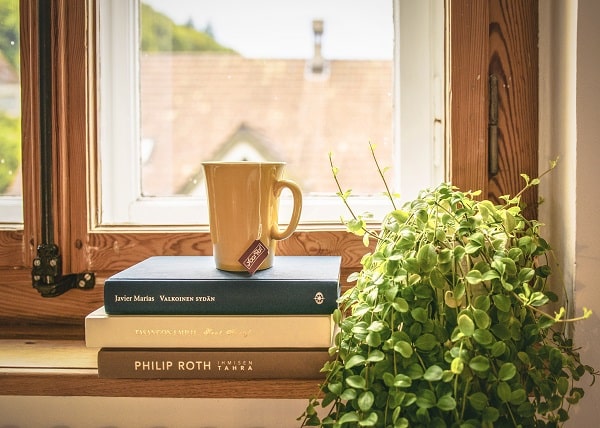We've independently reviewed this article to make sure it's as accurate as we can make it.
To find out more about our article creation and review process, check out our editorial guidelines.
Do you have a kitchen without window ventilation?
I’ve been there too! I know the struggle of battling against heat, steam, and unventilated air.
Luckily, there are different ways to improve the ventilation in your kitchen.
To improve ventilation in a kitchen without windows, open doors and turn on any fans well before cooking, open windows in nearby rooms, replace your range filters, add a tabletop fan blowing out of the door, and include a few air-purifying plants.
Read on to learn more about how to ventilate a kitchen without windows!
How to Ventilate a Kitchen Without Windows? 4 Simple Ways
If you have a windowless kitchen, don’t worry! I’ll guide you through 4 simple ways to improve ventilation.
#1 Use What’s Available
When I see a kitchen without window ventilation, my usual advice is to focus on improving circulation without any additional cost.
First, make sure to ‘prep’ the air before using the kitchen. Open the door(s), and switch on any range hoods or fans for a few minutes before you start cooking.
I find that allowing a few minutes for air circulation will ensure a refreshing environment by the time you enter the kitchen.
The worst way to handle an enclosed kitchen is to put the fans on after it gets too hot/steamy. It is much better to encourage airflow before the air gets warm.
Next, open up any nearby windows. Your kitchen may be windowless, but I’m sure you’re home isn’t! Aside from external fans, your main source of fresh air is from the rest of your home.
Opening windows on the opposite sides of your home/apartment encourages a lot of circulation – which is a big helper in getting air moving.
Finally, direct any small fans out of your kitchen. If you have any small countertop fans (these definitely help), make sure to point them across the kitchen towards the door to encourage the hot air to flow out rather than circle around your space.

Tip: When cooking in a windowless kitchen, I recommend using lids on pots to reduce moisture and prevent the buildup of humidity and odors.
#2 Use an Exhaust Fan
Usually, when I see a windowless kitchen, I install an exhaust fan to improve ventilation.
You see, an exhaust fan captures and distributes steam that you make while cooking. Doing so prevents moisture from building up in the ceiling, which can cause the ceiling paint to peel.
You can find kitchen exhaust fans in home improvement stores and online retailers. Try choosing the one that best fits your budget and needs.
#3 Install a Range Hood
I find that range hoods are great at improving ventilation in a windowless kitchen.
Range hoods can also mitigate the odor and trap the particulates from burnt cooking and grease.
You’ll find that range hoods come in various sizes and styles. So, please choose the one that fits your kitchen layout and budget.
Once you install the range hood, make sure to keep the filters clean to maintain the effectiveness of the ventilation system and prevent grease buildup.
If you want to get any replacement part – or see how much one would cost – click to enter your model number in the search bar below. Our partners at AppliancePartsPros stock almost every part with free guides on how to install them.

#4 Get Air Purifying Plants
You can also get air-purifying plants to improve the air quality in a kitchen with no windows.
It’s worth noting that combining air-purifying plants with other ventilation techniques is ideal for more effective results, as they don’t provide the same level of ventilation as the methods above.

According to Samantha Prattey, here are the five indoor plants that can help purify the air in your home:
- Barberton Daisy: Helps cleanse toxins like formaldehyde, trichloroethylene, and benzene that are present in household materials.
- Chrysanthemum: It filters a lot of toxins like ammonia and benzene.
- Aloe Vera: It can help soothe kitchen burns while purifying the air from formaldehyde and benzene.
- Dragon Tree: Aside from adding color to your space, the Dragon Tree plant can help fight pollutants like trichloroethylene and xylene.
- Weeping Fig: A popular indoor plant since the Victorian era, Weeping Figs fight formaldehyde, xylene, and toluene in the air.
Keep in mind, though, that there are varying ways to take care of any indoor plants. So, it is best to do some Googling before you purchase one.
Wrapping Up: Improving Ventilation in a Kitchen With No Windows
Hopefully, now you know how to improve the ventilation in a kitchen without windows.
Remember that if you have a windowless kitchen, you’ll need to open the doors and switch on any fans before you start cooking. It’s also important to open up any nearby windows.
You can also improve the ventilation by installing an exhaust fan or a range hood.
Thank you so much for reading. If you found this article helpful, please check out our other related guides below.
Good luck!







